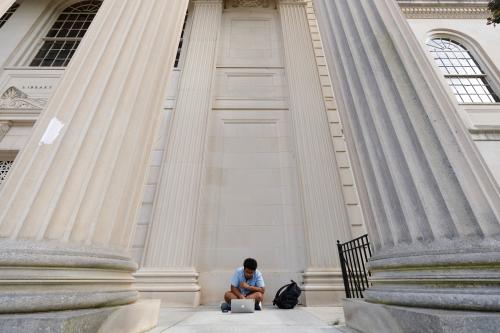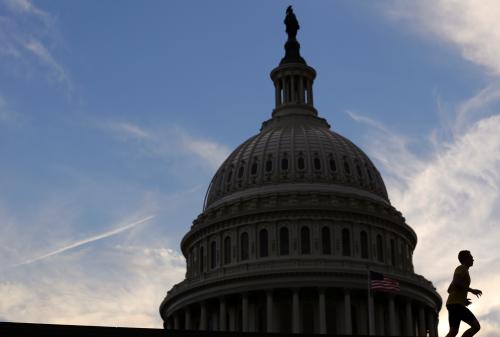This summarizes material from a comment to the Department of Education by Sandra E. Black, University of Texas; Stephanie Reigg Cellini, George Washington University; David J. Deming, Harvard University; Susan Dynarski, University of Michigan; Adam Looney, The Brookings Institution; Jordan Matsudaira, Columbia University; and Jesse Rothstein, University of California, Berkeley.
Several recent regulatory actions by the Department of Education (DoEd) have weakened accountability systems that monitor the use of federal financial aid in higher education. The Department proposed to gut the “borrower defense” rule, which offered protections and debt relief to students who had been misled or defrauded by their institution; to rescind the Gainful Employment (GE) rules, which tied federal funding to programs’ ability to “prepare students for gainful employment in a recognized occupation”; and to weaken rules governing distance learning and online education programs and allowing educational services to be outsourced to unaccredited providers.
A strong accountability system is necessary to protect the investments federal taxpayers make in students. Too many students and too much federal aid flow to low-quality educational programs that do not lead to degrees, or lead to degrees but not good jobs, and result in students incurring substantial costs and debts that burden them for years. A substantial body of economic research shows that institutions vary considerably in their quality and value, with some programs providing little economic value to students and/or resulting in poor financial outcomes. And accountability systems are demonstrated to improve student outcomes by limiting subsidies to low-quality institutions and redirecting enrollment elsewhere.
In response to the Department of Education’s rollback of accountability regulations, several prominent economists submitted comments to the Department describing the need for and benefits of strong accountability. In one comment, I and several colleagues (including Sandra Black of the University of Texas; Stephanie Riegg Cellini of George Washington University; David J. Deming of the Harvard Kennedy School; Susan Dynarski of the University of Michigan; Jordan Matsudaira of Columbia University; and Jesse Rothstein of the University of California, Berkeley) argued that the Department’s proposal ignores a large and growing body of evidence documenting the poor employment and financial outcomes that many students experience after enrolling at certain programs.
In our comment, we made several arguments about the value of a strong accountability system based on high-quality research studies—providing full citations to the evidence we draw from. After reviewing the literature, there is large consensus on the following:
- Large numbers of students enroll in occupational programs and leave with low earnings and loans that they cannot repay.
- An effective sanction regime would disproportionately affect for-profit programs that contribute most to problems student borrowers face—but not because of the characteristics of the students they serve.
- Regulations based on appropriate and robust measures of student outcomes, like debt, earnings, or repayment can help address the problems plaguing federally-supported students.
- Strong accountability systems improve economic outcomes of students by limiting access to low-quality, low-performing institutions, and redirecting students to better-performing institutions.
- Information disclosures, while important and necessary to the implementation of accountability systems, are insufficient to address the problems federal aid recipients face.
In addition, we encouraged other academic experts to submit their own comments and lend their expertise to the Department as it reformulated the Gainful Employment rule. (You too can submit comments on proposed rules—our how-to guide is available here.) Their views were similar.
“GE-type sanctions make sense because they effectively target the worst performing schools that account for a disproportionate share of the total potential loss to taxpayers (otherwise singling these schools out would not be fair),” writes Doug Webber of Temple University. He argued tolling back these rules, without a replacement, would have negative consequences for students and taxpayers.
“[R]escinding the GE rule will increase the number of students attending programs that generate little or no earnings gains, resulting in substantial costs resulting in substantial costs in the form of: 1) wasted tuition payments; 2) high levels of debt; and 3) lost earnings while pursuing a low-return education,” writes George Bulman of the University of California, Santa Cruz. “Further, rescinding the GE rule will impose a cost on taxpayers due to: 1) funding grants that do not generate meaningful earnings gains; 2) funding loans that do not generate meaningful earnings gains; and 3) absorbing the cost of loan defaults.”
Judith Scott-Clayton of Columbia University commented that the Gainful Employment rules appropriately focused on poor-performing institutions in the for-profit sector because “the probability of experiencing a poor outcome is dramatically higher for students entering for-profit institutions.” Moreover, she argued that the relatively poor performance was not driven by the characteristics of the students they served but of the institution itself. “[W]hile student characteristics certainly influence future outcomes…differences in student characteristics cannot explain the large differences in student loan default rates across [school] sectors,” writes. In her research, she finds that “[a]ccounting for a wide range of student and family background characteristics explains less than half of this overall gap in 12-year default rates among borrowers.”
Sanctions—not just information disclosure—are necessary to improve outcomes, argued Sandy Baum of the Urban Institute and Skidmore College. “The proposal to rely solely on improved information to guide student choices about postsecondary enrollment and borrowing is inconsistent with both the study cited and other scholarly research…” writes. “The students most likely to access and use this information are those with more resources, who are least likely to consider enrolling in inadequate institutions.”
The challenges many students face, including the rising burden of tuition costs and loan burdens, are not going to go away by themselves. To address these challenges, we need a reinvigorated accountability framework for federal student aid.
In our review of the literature, we highlighted several areas of consensus that are described more completely in this document.







Commentary
Accountability in higher education after deregulation
February 12, 2019